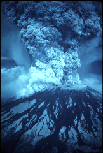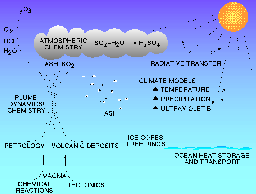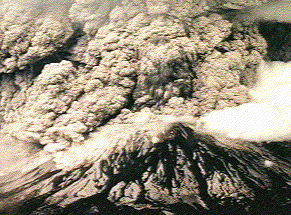 Introduction
Introduction


My name is Anna Latham. I am a first year geography student at Bristol university. Following lectures at the end of last term, I have chosen 'Volcanoes and Climate Change' as the subject for the web page that I am required to produce as part of the Computer Methods course that I take alongside geography in my first year. If anyone would like to e-mail me with any comments about my first web page - or highlight any spelling mistakes that may have crept into it along the way (!!) please CLICK HERE! This page probably doesn't contain any new information about volcanoes and climate change than you can already find on most other web pages on this subject. What I hope it will do is provide an overview of the main topics within the subject and easy access to relevant links to read about certain aspects of the page in more detail if you wish to do so.
 Introduction
Introduction
The scientific understanding of the environment of the Earth is increasing all the time. In climatology this increase has been most dramatic over the last 25 years. However, much still remains unknown, especially the record of past climatic variations and their causes. At the moment, global warming is at the top of the political agenda. The temperature increase of 0.3-0.6oC since the mid 19th century is taken as evidence that anthroprogenic increases in greenhouse gases are affecting the climate. This report focuses on a process counter to this namely; global cooling. In particular, the role that volcanic eruptions are thought to play in this 'negative forcing' (global cooling). Volcanoes have long been suspected of having an important effect on the climate. However, eruptions are rarely well documented, so it is very difficult to know what the climatic effects may be. The page is split up into the following sections:
 What happens in the atmosphere during/after a volcanic eruption?
What happens in the atmosphere during/after a volcanic eruption?
When a volcano erupts, the plume it emits contains three things:
The tephra is very heavy and falls back down to earth within a few days. It is the volcanic gases emitted that concern scientists. They contain sulphur dioxide (SO2). The SO2 particles react with water vapour in the air to form aerosols.
The diagram below shows these effects in diagrammatic form:
 Click here to see the full image
Click here to see the full image
These aerosols are responsible for the radiative forcing of the atmosphere. The following diagram shows the solar and terrestrial radiation balance (CALMET '95):
 Click here to see the full image,
Click here to see the full image,
Radiative forcing can be either:
Whether aerosols are warming or cooling depends on the size of the particles. If the particle is <2mm in diameter it has a cooling effect. If it is >2mm in diameter, it has a warming effect. Tropospheric aerosols found in the atmosphere due to pollution have a warming effect. The ones produced during volcanic eruptions reflect back incoming solar radiation, preventing it from reaching the earth’s surface, therefore volcanic aerosols have a cooling effect.
Mount Pinatubo erupted in the Philippines in 1991. The eruption cloud was 18km wide and 30km high. It contained 30x102 grams of aerosol, very rich in both sulphur and sulphur-dioxide. It had a very big atmospheric effect. After the eruption in 1991, 1992 was the coolest year on Earth for 30 years. Although the aerosols were emitted from a very small point i.e. the vent of the volcano, they are quickly distributed globally. They interfere with the energy input of the sun resulting in a cooling effect all over the globe.
There are two main indeces used to assess the probable climatic impact of volcanic eruptions: Various estimates have been given for the H2SO4 'yield' from major eruptions relating to the explosivity of the eruption. The table above shows that in terms of H2SO4 yield, the most important eruption of the last 500 years was a fissure eruption of Laki in Iceland (1783). This was a non-explosive eruption that lasted around 8 months. Tombora had the second highest H2SO4 yield, this was a much quicker, more violent, eruption. As yet there is no evidence of a connection then between the explosivity of an eruption and it's contribution of aerosols to the atmosphere and therefore no connection between the explosivity of an eruption and global cooling.
The impact an eruption has on the climate is more likely to be affected by the latitude of the volcano with high latitude eruptions having less impact than eruptions at lower latitudes where circulation is greater, there is more dispersal of the dust cloud and therefore a more global effect on the climate. Other influences the extent of an eruptions climatic impact include the height of the emission and the chemical composition of the emission (especially how much sulphur dioxide is emitted).
There are two other possible negative forcing factors. They are: In addition to these other negative forcing factors the case for global warming must be remembered. The IPCC Report suggested that the increase in anthroprogenic aerosols would counteract the warming occurring due to the increase in greenhouse gases. However, others have suggested that this 'cancelling out' effect would only be in the short term. Aerosols only survive for about one week in the atmosphere, greenhouse gases can remain in the troposphere for centuries. After the eruption of Mount Pinatubo in 1991, there was a marked global cooling the following year, but by 1993/4 the cooling was reversed as the aerosols fell out of the atmosphere. 1994 was recorded as being the fourth warmest year on record.
The diagram below compares the different radiative forcing mechanisms. Houghton, Jenkins, Ephraums eds, 1990:1990 IPCC, Cambridge University Press, fig2.6.
I have hopefully outlined how a volcano can contribute to global cooling and what factors affect the extent of an eruptions impact, as well as introducing the case for global warming and suggesting that there may be other processes operating that are also contributing to global cooling.
Right: Mt St Helens before the eruption.
 Mount Pinatubo
Mount Pinatubo
 How can the effect of an eruption on the climate be measured?
How can the effect of an eruption on the climate be measured?
 What factors affect the extent of the impact an eruption has on the climate?
The table below shows the relationship between the explosivity of an eruption and the amount of H2SO4 produced.
What factors affect the extent of the impact an eruption has on the climate?
The table below shows the relationship between the explosivity of an eruption and the amount of H2SO4 produced.
Eruption VEI rating H2SO4 (metric tons)
St. Helens, U.S.A 5 2.30x105
Laki, Iceland 4 9.03x107
St. Helens, U.S.A 4 3.50x103
Tambora, Indonesia 7 5.24x107
Coseguina, Nicaragua 5 0
Krakatau, Indonesia 6 2.94x106
Tarawera, New Zealand 5 5.00x106
Santa Maria, Guatemala 6 1.80x105
Soufriere, St. Vincent 4 2.40x105
Katmai, Alaska 6 7.90x106
Bezymianny, Kamchatka 5 6.00x106
Agung, Indonesia 4 2.84x106
St. Helens, U.S.A 5 7.90x104
El Chichon, Mexico 4 7.00x104  Are there any other things that could contribute to negative forcing in the atmosphere, other than volcanic eruptions?
Are there any other things that could contribute to negative forcing in the atmosphere, other than volcanic eruptions?
 Click here to see the full image.
Click here to see the full image.  Conclusion
Conclusion
It must be remembered that there is a great deal of uncertainty surrounding the subject of climate change in general.
Although some evidence can be found for the negative forcing effect of volcanic eruptions on the atmosphere. The record of explosive eruptions is still quite incomplete, especially relating to the chemical characteristics of the plumes produced during volcanic events. A complete chronology of eruption events is essential for a better understanding of the variability of the climate over the last, and the next, few centuries.
 Other useful links
Other useful links
http://spso2.gsfc.nasa.gov/NASA_FACTS/volcanoes/volcano.html
http://tgl.geology.muohio.edu/focus/VolcanoesandClimateChange.html
http://ww.circles.org/cdroms/CIESIN/nasafact/volc/volcano.htm
http://www.physics.iastate.edu//gcp/forcing/images.html
 Some pictures to finish!
Some pictures to finish!


Left: Mt St Helens during the eruption.